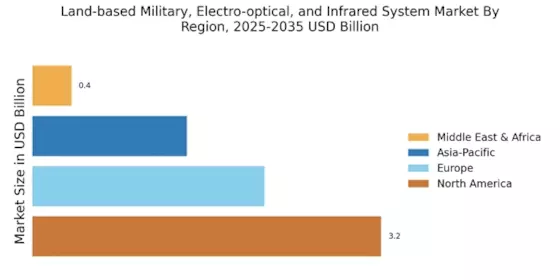Rising Defense Budgets
The increasing defense budgets across various nations appears to be a primary driver for the Land-based Military, Electro-optical, and Infrared System Market. Countries are allocating more resources to enhance their military capabilities, which includes investing in advanced electro-optical and infrared systems. For instance, recent reports indicate that defense spending in several regions has seen a rise of approximately 5 to 10% annually. This trend suggests a growing recognition of the importance of modern surveillance and targeting systems in military operations. As nations prioritize modernization, the demand for sophisticated land-based military systems is likely to escalate, thereby propelling the market forward.
Advancements in Sensor Technology
Technological innovations in sensor technology are transforming the Land-based Military, Electro-optical, and Infrared System Market. The development of high-resolution sensors and improved image processing capabilities enhances the effectiveness of military operations. Recent advancements have led to the creation of sensors that can operate in diverse environmental conditions, thereby increasing their utility in various military applications. The market for these advanced sensors is projected to grow at a compound annual growth rate of around 6% over the next five years. This growth indicates a strong demand for cutting-edge electro-optical and infrared systems that can provide superior performance in critical situations.
Focus on Modernization and Upgrades
The ongoing focus on modernization and upgrades of existing military systems is a significant driver for the Land-based Military, Electro-optical, and Infrared System Market. Many armed forces are recognizing the necessity of updating their legacy systems to meet contemporary operational requirements. This modernization effort often involves the integration of advanced electro-optical and infrared technologies to enhance situational awareness and combat effectiveness. Reports indicate that a substantial portion of defense budgets is being allocated to upgrade existing systems, which is expected to sustain market growth. As militaries strive to remain competitive, the demand for state-of-the-art systems will likely continue to rise.
Integration of Artificial Intelligence
The integration of artificial intelligence (AI) into military systems is emerging as a transformative factor in the Land-based Military, Electro-optical, and Infrared System Market. AI technologies enhance the capabilities of electro-optical and infrared systems by enabling real-time data analysis and decision-making. This integration allows for improved target recognition and tracking, which is crucial for modern military operations. As militaries seek to leverage AI to gain operational advantages, the demand for systems that incorporate these technologies is likely to increase. This trend suggests a shift towards more autonomous and intelligent military systems, potentially reshaping the market landscape.
Emerging Threats and Geopolitical Tensions
The evolving landscape of global security, characterized by emerging threats and geopolitical tensions, significantly influences the Land-based Military, Electro-optical, and Infrared System Market. Nations are increasingly aware of the need to bolster their defense mechanisms in response to potential conflicts. This awareness has led to a surge in demand for advanced surveillance and reconnaissance systems. For example, the rise in asymmetric warfare tactics necessitates the deployment of sophisticated electro-optical systems to ensure situational awareness. Consequently, military forces are investing in these technologies to maintain a strategic advantage, which is expected to drive market growth in the coming years.


















Leave a Comment